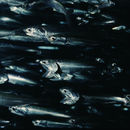Diagnostic Description
provided by FAO species catalogs
Body slender, elongate, rather round in cross-section, its depth about 5 to 6 times in standard length. Snout quite sharply pointed; maxilla moderate, tip sharply pointed, reaching to or almost to hind border of pre-operculum, projecting well beyond tip of second supramaxilla; tip of lower jaw below nostril. Lower gillrakers 37 to 45, long and slender; no gillrakers on hind face of third epibranchial. Anal fin origin under about base of last dorsal finray or a little behind. A silver stripe along flank in young individuals, disappearing with age. AnchoaA. delicatissimaAnchoviella balboae
Hart, (1973 - good summary).
- bibliographic citation
- FAO Species catalogue Vol. 7. Clupeoid fishes of the world. (Suborder CLUPEOIDEI) An annotated and illustrated catalogue of the herrings, sardines, pilchards, sprats, anchovies and wolf-herrings. Part 2. Engraulididae.Whitehead, P.J.P. 1985. FAO Fish. Synop., (125) Vol.7 Pt. 2:305-579.
- author
- Food and Agriculture Organization of the UN
Distribution
provided by FAO species catalogs
Eastern North Pacific (northern part of Vancouver Island south to Cape San Lucas, Baja California).
- bibliographic citation
- FAO Species catalogue Vol. 7. Clupeoid fishes of the world. (Suborder CLUPEOIDEI) An annotated and illustrated catalogue of the herrings, sardines, pilchards, sprats, anchovies and wolf-herrings. Part 2. Engraulididae.Whitehead, P.J.P. 1985. FAO Fish. Synop., (125) Vol.7 Pt. 2:305-579.
- author
- Food and Agriculture Organization of the UN
Size
provided by FAO species catalogs
To 24.8 cm total length (about 20.5 cm standard length), usually about 12 and 14 cm standard length at 2 and 3 years.
- bibliographic citation
- FAO Species catalogue Vol. 7. Clupeoid fishes of the world. (Suborder CLUPEOIDEI) An annotated and illustrated catalogue of the herrings, sardines, pilchards, sprats, anchovies and wolf-herrings. Part 2. Engraulididae.Whitehead, P.J.P. 1985. FAO Fish. Synop., (125) Vol.7 Pt. 2:305-579.
- author
- Food and Agriculture Organization of the UN
Brief Summary
provided by FAO species catalogs
Marine,pelagic, usually coastal and within about 30 km of shore, but to 480 km and down to 219 m depth,forming large tightly packed schools; enters bays and inlets (e.g., to about 2 km up Newport Bay, mainly in July and September - Horn & Alien, 1981:53).Feeds on euphausiids, copepods and decapod larvae (at least in British Colombia - Hart, 1973:105), both by random filter-feeding and by 'pecking' 60. at individual prey. Spawns from British Colombia south to Magdalena Bay, Baja California, but most abundantly between Point Conception and Point spring (January to March or April), but depending on hydrological conditions (preferred temperatures 10 to 23.3 °C in upper water layers and around 22.00 hours); eggs ellipsoidal, floating perpendicular at first, later horizontal, hatching in 2 to 4 days.
- bibliographic citation
- FAO Species catalogue Vol. 7. Clupeoid fishes of the world. (Suborder CLUPEOIDEI) An annotated and illustrated catalogue of the herrings, sardines, pilchards, sprats, anchovies and wolf-herrings. Part 2. Engraulididae.Whitehead, P.J.P. 1985. FAO Fish. Synop., (125) Vol.7 Pt. 2:305-579.
- author
- Food and Agriculture Organization of the UN
Benefits
provided by FAO species catalogs
Restricted by law solely as a baitfish in California in 1949 to 1955, but since then also used for canning or processing into fishmeal or oil, as also in British Colombia in the 1940's when very abundant.Wide fluctuations in populations, partly in relation to hydrology, but complicated by the relation with the also fluctuating populations of the California pilchard (Sardinops caeruleus). The recorded catch in 1982 was 294 859 t (247 997 t by Mexico), fished with lampara nets, but after about 1946 mainly by purse seines. The total catch reported for this species to FAO for 1999 was 11 137 t. The countries with the largest catches were Mexico(5 814 t) and USA (5 323 t).
- bibliographic citation
- FAO Species catalogue Vol. 7. Clupeoid fishes of the world. (Suborder CLUPEOIDEI) An annotated and illustrated catalogue of the herrings, sardines, pilchards, sprats, anchovies and wolf-herrings. Part 2. Engraulididae.Whitehead, P.J.P. 1985. FAO Fish. Synop., (125) Vol.7 Pt. 2:305-579.
- author
- Food and Agriculture Organization of the UN

